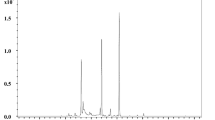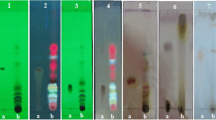Abstract
Pain is growing to be a massive health issue across the globe. It is reported that one in every five adults tends to suffer from pain worldwide each year, regardless of age and gender. Inflammation caused by tissue damage, chemical stimulus, and foreign substances is commonly associated with pain. Inflammatory pain is mainly caused by the direct effect of inflammatory mediators on particular classes of nociceptive neurons. In the current investigation, the antinociceptive and anti-inflammatory effect of corynoline, a phytochemical compound isolated from Corydalis bungeana Turcz., has been evaluated in experimental mice. The experimental mice were divided into 5 groups of 6 animals each. The first control group was fed with water. The second, third, and fourth groups received different doses of corynoline and the fifth group of mice received positive controls. Nociception was induced with the help of acetic acid, formalin, glutamate, capsaicin, hot plate, and tail immersion in mice whereas carrageenan was used to induce inflammation. The peritoneal cavity leukocyte infiltration and pro-inflammatory mediator generation were also analyzed to confirm the anti-inflammatory effect and the natural locomotor activity was determined using an open field test. Corynoline treatment significantly suppressed the paw licking, writhing in the abdominal region, and displayed high nociceptive inhibitory reaction in a dose-related manner. Additionally, corynoline significantly reduced the carrageenan-triggered paw edema and also reduced the levels of pro-inflammatory cytokines. Thus, the antinociceptive and anti-inflammatory activity of corynoline has been successfully established.







Similar content being viewed by others
Availability of Data and Materials
Not applicable.
References
Wang, J. (2019). Glial endocannabinoid system in pain modulation. International Journal of Neuroscience, 129(1), 94–100.
Wang, H. L., Li, Y. X., Niu, Y. T., Zheng, J., Wu, J., Shi, G. J., Ma, L., Niu, Y., Sun, T., & Yu, J. Q. (2015). Observing anti-inflammatory and anti-nociceptive activities of glycyrrhizin through regulating COX-2 and pro-inflammatory cytokines expressions in mice. Inflammation, 38(6), 2269–2278.
Bektas, N., Nemutlu, D., Ulugbay, G., & Arslan, R. (2015). The role of muscarinic receptors in pain modulation. World J pharm med, 1(1), 40–49.
Ronchetti, S., Migliorati, G., & Delfino, D. V. (2017). Association of inflammatory mediators with pain perception. Biomedicine & Pharmacotherapy, 96, 1445–1452.
Yang, C., Zhang, C., Wang, Z., Tang, Z., Kuang, H., & Kong, A. N. (2016). Corynoline isolated from Corydalis bungeana Turcz exhibits anti-inflammatory effects via modulation of Nfr2 and MAPKs. Molecules, 21(8), 975.
Cho, B. O., Ryu, H. W., So, Y., Lee, C. W., Jin, C. H., Yook, H. S., Jeong, Y. W., Park, J. C., & Jeong, I. Y. (2014). Anti-inflammatory effect of mangostenone F in lipopolysaccharide-stimulated RAW264. 7 macrophages by suppressing NF-κB and MAPK activation. Biomol Ther, 22(4), 288.
Hartung, J. E., Eskew, O., Wong, T., Tchivileva, I. E., Oladosu, F. A., O’Buckley, S. C., & Nackley, A. G. (2015). Nuclear factor-kappa B regulates pain and COMT expression in a rodent model of inflammation. Brain, behavior, and immunity, 50, 196–202.
García-Rayado, G., Navarro, M., & Lanas, A. (2018). NSAID induced gastrointestinal damage and designing GI-sparing NSAIDs. Expert review of clinical pharmacology, 11(10), 1031–1043.
Jaffal, S. M., Oran, S. A., & Alsalem, M. (2020). Anti-nociceptive effect of Arbutus andrachne L. methanolic leaf extract mediated by CB1, TRPV1 and PPARs in mouse pain models. Inflammopharmacology, 28(6), 1567–77.
de Cássia da Silveira, E Sá. R., Lima, T. C., de Nóbrega, F. R., de Brito, A. E. M., & de Sousa, D. P. (2017). Analgesic-like activity of essential oil constituents: An update. Int J Mol Sci, 18(12), E2392.
Dong, Z. B., Zhang, Y. H., Zhao, B. J., Li, C., Tian, G., Niu, B., Qi, H., Feng, L., & Shao, J. G. (2015). Screening for anti-inflammatory components from Corydalis bungeana Turcz. based on macrophage binding combined with HPLC. BMC complementary and alternative medicine, 15(1), 1.
Du, Y. X., Zhai, X. T., Zhu, F. X., & Wang, H. (2015). Study on UPLC Fingerprint of Corydalis bungeana. Zhongyaocai Journal of Chinese medicinal materials, 38(8), 1630–1633.
Liu, Y., Song, M., Zhu, G., Xi, X., Li, K., Wu, C., & Huang, L. (2017). Corynoline attenuates LPS-induced acute lung injury in mice by activating Nrf2. International Immunopharmacology, 48, 96–101.
Ankier, S. I. (1974). New hot plate tests to quantify antinociceptive and narcotic antagonist activities. European Journal of Pharmacology, 27(1), 1–4.
Koster, R. (1959). Acetic acid for analgesic screening. InFed proc, 18, 412.
Beirith, A., Santos, A. R., & Calixto, J. B. (2002). Mechanisms underlying the nociception and paw oedema caused by injection of glutamate into the mouse paw. Brain research, 924(2), 219–228.
Luiz, A. P., Moura, J. D., Meotti, F. C., Guginski, G., Guimaraes, C. L., Azevedo, M. S., Rodrigues, A. L., & Santos, A. R. (2007). Antinociceptive action of ethanolic extract obtained from roots of Humirianthera ampla Miers. Journal of Ethnopharmacology, 114(3), 355–363.
Gomes, N. M., Rezende, C. M., Fontes, S. P., Matheus, M. E., & Fernandes, P. D. (2007). Antinociceptive activity of Amazonian Copaiba oils. Journal of Ethnopharmacology, 109(3), 486–492.
Agrahari, A. K., Khaliquzzama, M., & Panda, S. K. (2010). Evaluation of analgesic activity of methanolic extract of Trapa natans l. var. Bispinosa roxb. Roots. Int J Curr Pharm Res, 1(1), 8–11.
De Mattos, E. S., Frederico, M. J., Colle, T. D., De Pieri, D. V., Peters, R. R., & Piovezan, A. P. (2007). Evaluation of antinociceptive activity of Casearia sylvestris and possible mechanism of action. Journal of Ethnopharmacology, 112(1), 1–6.
Passos, G. F., Fernandes, E. S., da Cunha, F. M., Ferreira, J., Pianowski, L. F., Campos, M. M., & Calixto, J. B. (2007). Anti-inflammatory and anti-allergic properties of the essential oil and active compounds from Cordia verbenacea. Journal of Ethnopharmacology, 110(2), 323–333.
Vinegar, R., Truax, J. F., & Selph, J. L. (1973). Some quantitative temporal characteristics of carrageenin-induced pleurisy in the rat. Proceedings of the Society for Experimental Biology and Medicine, 143(3), 711–714.
Edwards, J. C., Sedgwick, A. D., & Willoughby, D. A. (1981). The formation of a structure with the features of synovial lining by subcutaneous injection of air: An in vivo tissue culture system. The Journal of Pathology, 134(2), 147–156.
Zachariou, V., & Carr, F. (2014). Nociception and pain: Lessons from optogenetics. Frontiers in Behavioral Neuroscience, 8, 69.
Weng, W., Wang, F., He, X., Zhou, K., Wu, X., & Wu, X. (2021). Protective effect of corynoline on the CFA induced rheumatoid arthritis via attenuation of oxidative and inflammatory mediators. Molecular and Cellular Biochemistry, 476(2), 831–839.
De Souza, M. M., Pereira, M. A., Ardenghi, J. V., Mora, T. C., Bresciani, L. F., Yunes, R. A., Delle Monache, F., & Cechinel-Filho, V. (2009). Filicene obtained from Adiantum cuneatum interacts with the cholinergic, dopaminergic, glutamatergic, GABAergic, and tachykinergic systems to exert antinociceptive effect in mice. Pharmacology, Biochemistry and Behavior, 93(1), 40–46.
Singh, G., Kaur, J., Kaur, M., Singh, P., & Bhatti, R. (2020). Anti-nociceptive and anti-inflammatory effect of imperatorin: Evidences for involvement of COX-2, iNOS, NFκB and inflammatory cytokines. International Journal of Neuroscience, 130(2), 176–185.
Liu, Y., Samad, O. A., Zhang, L., Duan, B., Tong, Q., Lopes, C., Ji, R. R., Lowell, B. B., & Ma, Q. (2010). VGLUT2-dependent glutamate release from nociceptors is required to sense pain and suppress itch. Neuron, 68(3), 543–556.
Lam, D. K., Sessle, B. J., Cairns, B. E., & Hu, J. W. (2005). Neural mechanisms of temporomandibular joint and masticatory muscle pain: A possible role for peripheral glutamate receptor mechanisms. Pain Research & Management, 10(3), 145–152.
Xu, Q., Wang, Y., Guo, S., Shen, Z., Wang, Y., & Yang, L. (2016). Anti-inflammatory and analgesic MAPKs. Molecules, 21(8), 975.
Sani, M. H., Zakaria, Z. A., Balan, T., Teh, L. K., Salleh, M. Z. (2012). Antinociceptive activity of methanol extract of Muntingia calabura leaves and the mechanisms of action involved. Evidence-Based Complementary and Alternative Medicine, 2012.
Singh, G., Bhatti, R., Mannan, R., Singh, D., Kesavan, A., & Singh, P. (2019). Osthole ameliorates neurogenic and inflammatory hyperalgesia by modulation of iNOS, COX-2, and inflammatory cytokines in mice. Inflammopharmacology, 27(5), 949–960.
Tsai, D. S., Huang, M. H., Tsai, J. C., Chang, Y. S., Chiu, Y. J., Lin, Y. C., Wu, L. Y., & Peng, W. H. (2015). Analgesic and anti-inflammatory activities of Rosa taiwanensis nakai in mice. Journal of Medicinal Food, 18(5), 592–600.
Lam, D. K., Sessle, B. J., & Hu, J. W. (2009). Glutamate and capsaicin effects on trigeminal nociception I: Activation and peripheral sensitization of deep craniofacial nociceptive afferents. Brain research, 1251, 130–139.
Santos, F. A., Jeferson, F. A., Santos, C. C., Silveira, E. R., & Rao, V. S. (2005). Antinociceptive effect of leaf essential oil from Croton sonderianus in mice. Life Sciences, 77(23), 2953–2963.
Afsar, T., Khan, M. R., Razak, S., Ullah, S., & Mirza, B. (2015). Antipyretic, anti-inflammatory and analgesic activity of Acacia hydaspica R Parker and its phytochemical analysis. BMC complementary and alternative medicine, 15(1), 1–2.
Rosa, S. G., Brüning, C. A., Pesarico, A. P., de Souza, A. C., & Nogueira, C. W. (2018). Anti-inflammatory and antinociceptive effects of 2, 2-dipyridyl diselenide through reduction of inducible nitric oxide synthase, nuclear factor-kappa B and c-Jun N-terminal kinase phosphorylation levels in the mouse spinal cord. Journal of Trace Elements in Medicine and Biology, 48, 38–45.
Niu, X., Li, Y., Li, W., Hu, H., Yao, H., Li, H., & Mu, Q. (2014). The anti-inflammatory effects of Caragana tangutica ethyl acetate extract. Journal of Ethnopharmacology, 152(1), 99–105.
Yang, C., Zhang, C., Wang, Z., Tang, Z., Kuang, H., & Kong, A. N. (2016). Corynoline isolated from Corydalis bungeana Turcz. exhibits anti-inflammatory effects via modulation of Nfr2 and Corydalis bungeana Turcz. attenuates LPS-induced inflammatory responses via the suppression of NF-κB signaling pathway in vitro and in vivo. J Ethnopharmacol, 194, 153–61.
Zhai, X. T., Chen, J. Q., Jiang, C. H., Song, J., Li, D. Y., Zhang, H., Jia, X. B., Tan, W., Wang, S. X., Yang, Y., & Zhu, F. X. (2014). Activity of aqueous extract of Flos populi. J Ethnopharmacol, 152(3), 540–5.
Liu, B., Su, K., Wang, J., Wang, J., Xin, Z., Li, F., & Fu, Y. (2018). Corynoline exhibits anti-inflammatory effects in lipopolysaccharide (LPS)-stimulated human umbilical vein endothelial cells through activating Nrf2. Inflammation, 41(5), 1640–1647.
Author information
Authors and Affiliations
Contributions
All authors contributed equally.
Corresponding author
Ethics declarations
Ethics Approval
Ethical statement for “Antinociceptive and anti-inflammatory effect of bioactive compound in different nociceptive and inflammatory experimental models”.
Issue No: BJH202178091
Consent to Participate
All authors have their consent to participate.
Consent to Publish
All authors have their consent to publish their work.
Competing Interests
The authors declare no competing interests.
Additional information
Publisher's Note
Springer Nature remains neutral with regard to jurisdictional claims in published maps and institutional affiliations.
Rights and permissions
About this article
Cite this article
Lei, F., Yan, Z. Antinociceptive and Anti-inflammatory Effect of Corynoline in Different Nociceptive and Inflammatory Experimental Models. Appl Biochem Biotechnol 194, 4783–4799 (2022). https://doi.org/10.1007/s12010-022-03843-6
Accepted:
Published:
Issue Date:
DOI: https://doi.org/10.1007/s12010-022-03843-6




